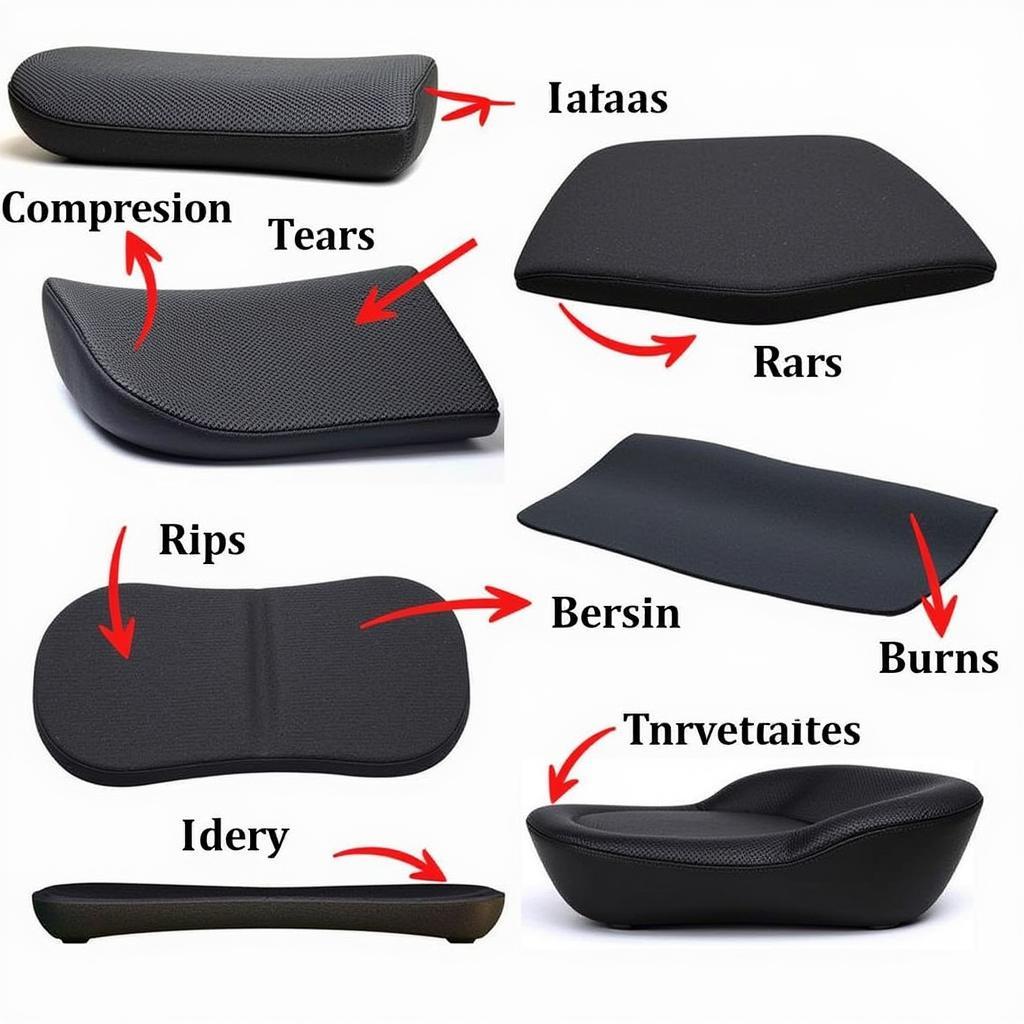Car seat foam can deteriorate over time, leading to discomfort and a less appealing interior. Knowing How To Fix Car Seat Foam can save you money and restore the comfort of your ride. This guide will provide you with various methods for repairing car seat foam, from simple fixes to more involved repairs. Learn how to diagnose the problem, choose the right materials, and execute the repair effectively.
Identifying the Problem with Your Car Seat Foam
Before you start fixing your car seat foam, it’s crucial to pinpoint the exact issue. Is it a small tear, a large rip, a compression issue, or perhaps a burn? Accurately identifying the problem will guide you towards the most effective repair strategy. For instance, a small tear might only require a patch, while a large area of collapsed foam might necessitate replacement. fixing car seat foam indentation offers some helpful tips for addressing indentations.
Common Car Seat Foam Issues
Some common problems with car seat foam include:
- Compression/Sagging: This is often due to years of use and the foam losing its resilience.
- Tears and Rips: Sharp objects or even regular wear and tear can cause tears and rips in the foam.
- Burns: Cigarette burns are a common culprit for small holes in car seat foam. If you’re dealing with this issue, check out how to fix burn holes in fabric car seats.
- Indentation: Objects placed on the seat for extended periods can leave lasting indentations.
 Types of Car Seat Foam Damage
Types of Car Seat Foam Damage
Gathering the Necessary Materials for Car Seat Foam Repair
Once you’ve identified the problem, gather the necessary tools and materials. This might include:
- Foam repair kit
- Upholstery adhesive
- Scissors
- Utility knife
- Replacement foam (if needed)
- Hog ring pliers (for reattaching upholstery)
Having the right materials at hand will make the repair process much smoother. Remember, using the right adhesive is critical for a long-lasting fix.
Choosing the Right Foam
If you need to replace a section of foam, choosing the right type is essential. Consider the density and firmness of the original foam. Using a mismatched foam can lead to an uncomfortable and uneven seating surface. For leather seats, you might want to check out fix car sagging leather.
 Tools and Materials for Car Seat Foam Repair
Tools and Materials for Car Seat Foam Repair
Step-by-Step Guide to Fixing Car Seat Foam
Here’s a general guide for fixing minor tears and compression issues:
- Clean the area: Use a suitable cleaner to remove dirt and debris from the affected area.
- Prepare the foam: If using a repair kit, follow the instructions for preparing the filler.
- Apply the filler: Carefully apply the filler to the damaged area, ensuring it fills the gap or tear completely.
- Smooth the surface: Use a spatula or your fingers to smooth the filler and create an even surface.
- Allow to dry: Let the filler dry completely according to the manufacturer’s instructions.
- Reattach upholstery (if necessary): If you had to remove the upholstery, carefully reattach it using hog ring pliers. fix a sagging or leaning car seat provides guidance on dealing with sagging or leaning seats.
For more significant damage, replacing the foam might be necessary. This typically involves removing the upholstery, cutting out the damaged foam, and replacing it with a new piece.
“When dealing with larger tears, remember to measure twice and cut once,” advises John Miller, a veteran auto upholsterer with over 20 years of experience. “Accurate measurements are key to ensuring a seamless repair.”
How to Prevent Future Car Seat Foam Damage
Protecting your car seat foam can extend its lifespan and prevent future repairs. Here are some tips:
- Use seat covers: Seat covers can protect your seats from spills, stains, and wear and tear.
- Avoid placing sharp objects on the seats: This can prevent tears and rips in the foam.
- Clean your seats regularly: Regular cleaning can remove dirt and debris that can contribute to wear and tear.
“Regular maintenance is key to preserving the condition of your car seats,” emphasizes Maria Sanchez, an automotive detailing expert. “A little care can go a long way in preventing costly repairs down the road.” how to fix tear in leather car seat can help you address tears in leather.
Conclusion
Fixing car seat foam can be a relatively straightforward process, depending on the extent of the damage. By following the steps outlined in this guide and using the right materials, you can restore your car seats’ comfort and appearance. Remember, preventative measures can help extend the life of your car seat foam and minimize the need for future repairs. For any further assistance or inquiries, feel free to contact AutoTipPro at +1 (641) 206-8880 or visit our office at 500 N St Mary’s St, San Antonio, TX 78205, United States. We’re here to help you with all your automotive needs, including how to fix car seat foam.




Leave a Reply